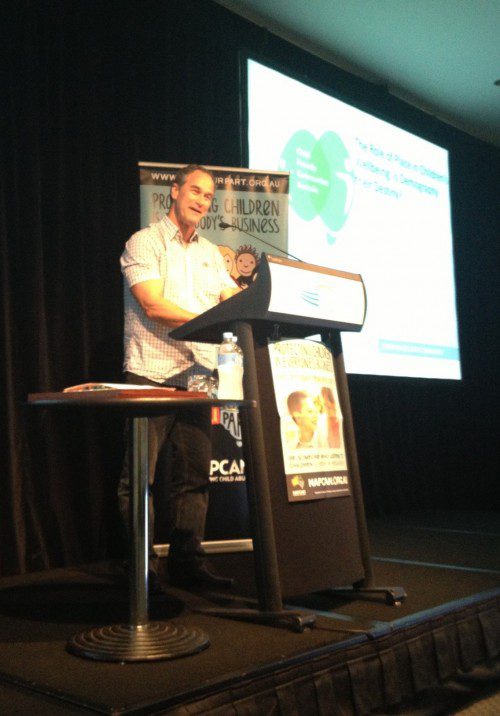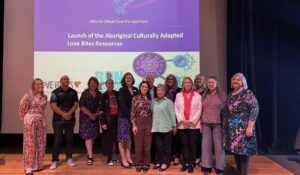Photo: Professor Geoff Woolcock speaking at NT NCPW 2013 Breakfast.
Thought provoking interview of Lesley Taylor, NAPCAN NT, Geoff Woolcock, associate professor in urban research at Griffith University, and Dr Howard Bath, NT Children’s Commissioner. Interview by Neda Vanovac, AAP.
Child abuse in Australia should be viewed the same way as smoking – as a primary health problem with huge ramifications, a child protection advocate says.
Lesley Taylor, the Northern Territory manager of the National Association for Prevention of Child Abuse and Neglect (NAPCAN), says Australia is too reliant on child protection services to flag when children are in trouble.
“What we want to have ultimately is no more child protection at all,” she told AAP, saying that investments should be made in community-based programs.
“(Protection) services are needed, but should be very small systems for those families whose needs can’t be met by their own community,” she says.
This week is Child Protection Week, and advocates are hoping to make people aware that child safety is everyone’s responsibility, be it in a city, the suburbs or a remote town.
And yet the numbers are climbing: nationally, over the year to June 2012, the number of children subjected to abuse or neglect increased from 31,527 to 37,781.
Ms Taylor says investing in family support and parenting programs rather than policing would dramatically shift Australian society.
“Affordable childcare is one of the most potentially powerful things we could provide to families,” she says.
“Child protection systems are failing in every state, in every country.”
The negative results of child abuse are “extraordinary” she says, with far further-reaching impacts than political parties will admit.
“Look how we took on smoking: we’ve put pressure onto public health systems, so let’s view child protection in the same model, as a primary health issue.”
And a health issue it is: a generation of kids raised on junk food and a lack of outdoor play will result in some dying early from preventable lifestyle diseases such as diabetes, says Geoff Woolcock, associate professor in urban research at Griffith University.
“All indications are that this generation will not outlive its parents – this ought to be a wake-up call,” he says.
The statistics around domestic violence and child abuse in the Territory are shocking, says the NT’s Children’s Commissioner, Dr Howard Bath.
He points to Australian Bureau of Statistics figures that show Aboriginal women have 80 times the risk of being hospitalised for assaults.
In the last counting period to 2010, there were 27 non-indigenous women and 842 Aboriginal women hospitalised for assault in the five hospitals across the NT in a one-year period.
“A lot of it has to do with the sheer overwhelming conditions,” Dr Bath says.
“It’s overcrowded, there’s a lack of employment opportunities, boredom, and when you add alcohol you get a very volatile mixture. (It’s) a tragedy unfolding for women and children.”
However, the news isn’t all bad.
Although the NT has by far the worst child wellbeing indicators of any jurisdiction, “we are seeing for the first time some encouraging trends around child wellbeing as a result of the huge investment,” Dr Bath says.
“It’s a very slow process because you’re talking about parents carrying the wounds of trauma with them into the next generation. You’re talking about something that can’t just turn around very quickly.”
But he says that the first two waves of the Australian Early Development Index, from 2009 and 2012, show that NT kids at age five are improving in their capacity to socially relate, along with better physical and social health and cognitive abilities.
The index, based on information collected on 96.5 per cent of Australian children in their first year of formal full-time school, showed that between the two test periods the number of developmentally vulnerable indigenous children dropped from almost half to just over 40 per cent.
The Index’s report also found that the majority of Aboriginal and Torres Strait Islander children are developmentally on track.
But even though the majority are doing well, they are still more than twice as likely to be developmentally vulnerable than non-indigenous children.
“We’re seeing marked improvement over the last three years of wellbeing of Aboriginal kids, so there are some glimmers of hope,” Dr Bath said.
Link to Article on Yahoo 7 news




